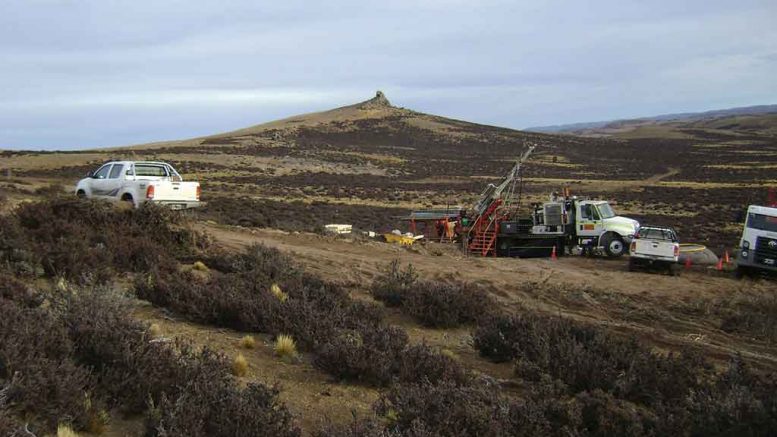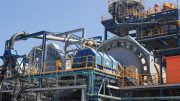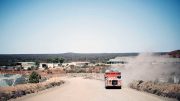Mirasol Resources (TSXV: MRZ), a precious metals explorer using the prospect-generator model, says prospecting along the Resolution trend at its wholly owned Nico property in the Deseado Massif region of Santa Cruz province, Argentina, has yielded rock chip assays of 528 grams silver per tonne and 5.73 grams gold per tonne, which could be part of a silver-rich epithermal sulphidation system.
In fact, Mirasol says Resolution “represents an attractive drill target for bulk-mineable, gold-silver mineralization.”
Without further drilling no one knows for certain, but it wouldn’t be the first — or the second.
The Deseado Massif’s unique geology has a knack for hosting shallow, world-class gold-silver deposits.

Map of the southern Argentina’s Deseado Massif gold-silver district, showing Patagonia Gold’s properties and other prominent projects and mines. Credit: Patagonia Gold.
“The geologic province hosts high- and low-grade, low-sulphidation epithermal precious metal deposits related to Jurassic-aged volcanism,” said Brent Cook, geologist and editor of Exploration Insights, a subscriber-based newsletter that follows Mirasol, among other companies. He adds that the Deseado Massif “hosts some big mines, including Cerro Negro and Cerro Vanguardia.”
Cerro Negro is in the northwest corner of the Deseado Massif, 20 km south of the San Jose underground gold-silver mine, owned 49% by McEwen Mining (TSX: MUX; NYSE: MUX), with Hochschild Mining (LON: HOC; US-OTC: HCHDF) owning the rest.
Goldcorp’s (TSX: G; NYSE: GG) Cerro Negro produced 452,000 oz. gold in 2017, which amounted to almost 20% of the company’s revenue and 14% of gold production.
And it’s not about to wane.

Goldcorp’s Cerro Negro gold mine in southern Argentina’s Santa Cruz province. Credit: Goldcorp.
Goldcorp guidance pegs Cerro Negro’s 2018 production at 490,000 oz. gold at all-in sustaining costs (AISCs) of US$600 per ounce. The major acquired the asset after a US$3.6-billion takeover of Andean Resources in 2015.
Meanwhile, AngloGold Ashanti’s (NYSE: AU) 92.5%-owned Cerro Vanguardia gold-silver mine in Magallanes, Santa Cruz — the “old man” among the Santa Cruz gold mines — has produced for 17 years and in 2016 turned out 281,000 oz. gold at AISCs of US$773 per ounce. State-owned Formicruz owns 7.5%.
Yamana Gold’s (TSX: YRI; NYSE: AUY) 2018 entrant into the fray, Cerro Moro, situated 70 km southwest of the coastal city of Puerto Deseado, has a number of high-grade epithermal gold and silver deposits that will be mined by open-pit and underground methods.
It could produce 85,000 oz. gold and 3.75 million oz. silver this year and yield 180,000 oz. gold and 7 million oz. silver annually within a few years.

Yamana Gold’s Cerro Moro project in Santa Cruz, Argentina. Credit: Yamana Gold.
Sandstorm Gold (TSX: SSL; NYSE-AM: SAND) has a silver-streaming agreement to buy from Cerro Moro up to 1.2 million oz. silver annually — until it reaches 7 million oz. silver — and 9% of the life-of-mine silver produced afterward.
Sandstorm will pay 30% of the silver spot price for each ounce. Sandstorm paid US$70 million to acquire the stream in October 2015. Yamana acquired Cerro Moro when it bought Extorre Gold Mines in 2012 for $400 million.
These kinds of company-maker assets lure investors and allow companies to raise cash for exploration.
The next stage of exploration at Mirasol’s Nico project will include geological mapping, more chip sampling and geophysical surveys. The results will determine if any targets should be drilled later this year.

Stephen Nano (left), Mirasol Resources’ CEO, and Damien Koerber, business development manager, at the discovery outcrop at the Aurora gold-silver prospect on the Nico property in Argentina. Mirasol Resourcees
The junior is exploring a number of other projects in the Deseado Massif with its joint-venture partners, including La Curva and Claudia with OceanaGold (TSX: OGC).
Mirasol has had some success with its prospect-generator model. In 2012, it sold its 49% interest in the Joaquin silver-gold project in Santa Cruz to Coeur Mining (TSX: CDM; NYSE: CDE) for US$30 million in cash and another US$30 million in shares.
Coeur later flipped Joaquin to Pan American Silver (TSX: PAAS; NASDAQ: PAAS) in 2017 for US$15 million and US$10 million in stock.
Pan American is no stranger to the Deseado Massif. It operates Manantial Espejo, a tried and tested open-pit and underground silver-gold mine that sits on 17 mineral concessions in the district. The mine started operations in 2008 and Pan American’s guidance suggests the mine should produce another 3.2 million to 3.3 million oz. silver and 28,500 oz. gold in 2018.
In 2017, Pan American acquired the Cap-Oeste Sur Este (COSE) high-grade silver project, 180 km north of Manantial Espejo, from Patagonia Gold (LON: PGD) for US$15 million, plus a 1.5% net smelter return royalty.
Pan American is spending US$24 million to build a 1 km underground decline at COSE, which should reach the first stoping area near the end of 2018. The ore would be trucked to Manantial Espejo for processing.
The tidy side project is expected to produce 2.02 million oz. silver and 41,400 oz. gold over a year and a half, likely beginning in early 2019.
Patagonia Gold, meanwhile, is using the money from the sale to develop its flagship Cap-Oeste heap-leach project, north of COSE, in the Deseado Massif.
Patagonia reports that Cap-Oeste produced 26,005 equivalent oz. gold in 2017 at cash costs of US$711 per equivalent oz. gold. The company expects to more than double production in 2018.

Processing facilities at Hunt Mining’s Martha mine in Argentina. Credit: Hunt Mining.
Patagonia Gold is also exploring the El Tranquilo, La Paloma, La Manchuria and Sarita projects in the region. Sarita is just north of Hunt Mining’s (TSXV: HMX) Martha mine, which shipped concentrate containing 549,000 oz. silver and 624 oz. gold in 2017.
Hunt is using any cash from Martha to develop its La Josephina and La Valencia gold-silver properties.
New Dimension Resources (TSXV: NDRV) recently acquired 100% interests in the Las Calandrias, Los Cisnes and Sierra Blanca gold-silver projects located in the Deseado Massif from Sandstorm Gold. The portfolio, totalling 860 sq. km, was held by Mariana Resources before it was acquired by Sandstorm in July 2017.
Austral Gold (TSXV: AGLD) continues to advance its 135 sq. km Pinguino silver-zinc-lead-gold-indium property in the Deseado Massif.
Pinguino is part of a large vein system along the Tranquilo Fault. Cerro Vanguardia is situated along the same fault, 35 km south.
While more than 70 veins have been found at Pinguino, only 37 have been drill tested.
One intercept in Pinguino’s Marte Norte zone hit 6 metres running 476 grams silver per tonne and 1.08 grams gold, while another in Marta Centro hit 12.7 metres of 141 grams per tonne silver, 0.44 gram gold, 3.3% lead and 6% zinc.
So far, 69,500 metres have been drilled on Pinguino, and Austral is working towards a preliminary economic assessment in 2018.
Austral secured its interests in both Pinguino and its 70%-owned Casposo silver-gold mine, farther north in San Juan province, when it bought Argentex Mining in 2016.
Despite the lengthy list of discoveries and takeovers, Cook says the Deseado Massif probably remains largely underexplored. So, will there be more world-class discoveries?
“Yes,” Cook said. “There will be more.”
— Based in Toronto, Brian Sylvester is a freelance business writer specializing in mining.






Be the first to comment on "Discovery-takeover cycle continues in Argentina’s Deseado Massif"